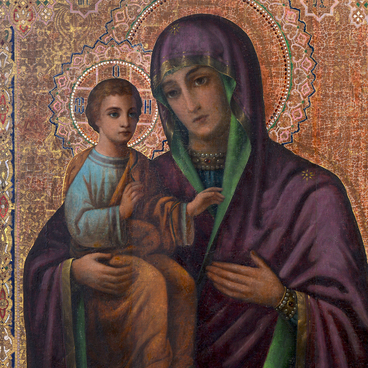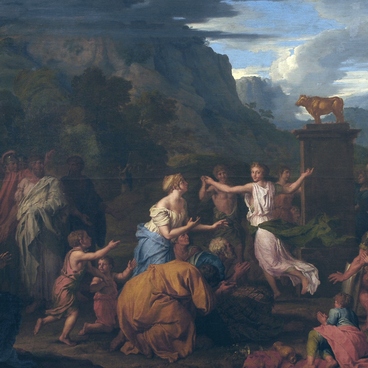VasIly ROdchev’s (1768–1803) artistic path is intertwined with the history of the Academy of Arts: it was founded in Saint Petersburg in 1757, the painter was born a year later. He spent a total of 15 years in the Academy and successfully graduated in 1788 with a gold medal — the Academy’s most honorable award that entitled the awardee to travel abroad. ‘ApOllo orders satyrs to tie MArsyas to a tree’ was the master’s graduation artwork. It represents the most distinctive features of classical art, a cultural movement that dominated visual arts throughout the 18th century.
The painting is based on a mythological plot, as was required by the laws of the Academy. It was supposed to represent the notion of an ideal human and society. To focus the viewer’s attention on the didactic aspect of the artwork, the artist used his characters to depict the fight between light and darkness. Apollo represents order and harmony, triumphing over brute force embodied by Marsyas.
The contest between Apollo and Marsyas is a recurring episode in the history of art. It is a myth about how a beautiful god and patron of arts competed with a derisive satyr. For his artwork, Rodchev used a scene where Apollo was declared the winner of the music contest. He punished Marsyas who dared to challenge him and tied the satyr up to a pine tree.
The classical style is reflected in the artwork’s composition. The canvas is strictly divided into the light side and the dark side. We can also tell the classical style by how the characters are placed in the painting. The artist depicts his characters using classical antiquity sculpture as a reference. It is known that the image of the protagonist is based on the sculpture of Apollo BelvedEre. The way characters on the right are pictured can be traced to the famous statue of LaocoOn and His Sons.
After graduating from the Academy of Arts, Vasily Rodchev devoted himself to history painting and the art of portraits. He left a modest legacy. One of the master’s most famous artworks is in the possession of Novosibirsk State Art Museum. The Museum obtained it in 1958, making it one of the first pieces in the collection. Prior to that, the painting had been discovered in a private collection in Leningrad. The owner ascribed it to Russian painter A. A. Ivanov. However, the archives of the Saint Petersburg Academy of Arts helped art critics determine the authorship of the canvas.
The painting is based on a mythological plot, as was required by the laws of the Academy. It was supposed to represent the notion of an ideal human and society. To focus the viewer’s attention on the didactic aspect of the artwork, the artist used his characters to depict the fight between light and darkness. Apollo represents order and harmony, triumphing over brute force embodied by Marsyas.
The contest between Apollo and Marsyas is a recurring episode in the history of art. It is a myth about how a beautiful god and patron of arts competed with a derisive satyr. For his artwork, Rodchev used a scene where Apollo was declared the winner of the music contest. He punished Marsyas who dared to challenge him and tied the satyr up to a pine tree.
The classical style is reflected in the artwork’s composition. The canvas is strictly divided into the light side and the dark side. We can also tell the classical style by how the characters are placed in the painting. The artist depicts his characters using classical antiquity sculpture as a reference. It is known that the image of the protagonist is based on the sculpture of Apollo BelvedEre. The way characters on the right are pictured can be traced to the famous statue of LaocoOn and His Sons.
After graduating from the Academy of Arts, Vasily Rodchev devoted himself to history painting and the art of portraits. He left a modest legacy. One of the master’s most famous artworks is in the possession of Novosibirsk State Art Museum. The Museum obtained it in 1958, making it one of the first pieces in the collection. Prior to that, the painting had been discovered in a private collection in Leningrad. The owner ascribed it to Russian painter A. A. Ivanov. However, the archives of the Saint Petersburg Academy of Arts helped art critics determine the authorship of the canvas.

